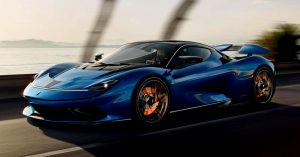In 1980, Audi introduced a significant car to the world, Quattro.
It was the father of all 4-wheel-drive cars today as well as the label now sticking on all 4WD Audis.
However, its success was not limited to the innovative 4-wheel-drive system. Quattro was also a rare combination of style, performance, handling and 4-seat practicality
As for the car, it was derived from the Audi 80 platform, but fitted with the MacPherson strut suspensions and engine from Audi 200. The contemporary 80 was not a specially beautiful sedan, but Audi did a good job to the Quattro coupe. It sharpened its edges and reshaped it to a 3-door hatchback. The slightly pronounced wheelarches not only housed wider wheels but also added to the sporty appeal. The triangular C-pillar with pseudo ventilation grilles at its base was particularly stylish, as was the 4-ring graphics appeared below the belt line – they reminded people this car had 4-wheel-drive.

The engine was derived from the forthcoming 200 Turbo. Audi’s unique inline-5-cylinder engine displaced 2144 cc and boosted by a KKK turbocharger. The result was 200 horsepower at 5500 rpm and 210 lbft of torque at 3500 rpm. This allowed Autocar magazine to record 7.3 seconds from 0 to 60 mph and 135 mph in 1981, which was remarkable then. By the standard of the 1980s turbocharged engines, Audi’s turbocharged five-pot was particularly impressive for its characterful sound, smoothness and relatively less turbo lag. But turbo lag still existed. It needed around 3000 rpm to get into sweet zone. That’s not much of a problem then, but as time went by, newly emerging rivals like Porsche 944 raised the game with torquey and responsive naturally aspirated engines. In 1987, Audi bored out the five-pot to 2226 cc along with higher compression and water-cooled turbocharger. Maximum output remained unchanged, but there was more torque available at low rpm. In 1989, the last evolution added a twin-cam 20-valve head to boost power to 220 hp. Peak torque now raised to 228 lbft and it took just 1950 rpm to realize. By then the turbo lag became negligible.

Inside, the cabin was 80-like, placing function over style. The good news was that it was a genuine 4-seater, or even an occasional 5-seater ! Audi not only did not shorten its wheelbase, but stretched it by 0.5 inches. Moreover, the slope of the rear screen hit the right balance between style and rear headroom. In addition to excellent ergonomics and comfortable seats, the Quattro was a good long-distance coupe.

General characteristics


Engine
Configuration: Straight 5
Location: Front, longitudinally mounted
Construction: aluminium alloy block and head
Displacement: 2.11 liter / 128.8 cu in
Bore / Stroke: 79.5 mm (3.1 in) / 85.0 mm (3.3 in)
Compression: 7.5:1
Valvetrain: 4 valves / cylinder, DOHC
Fuel: feed Fuel Injection
Lubrication: Dry sump
Aspiration: KKK Turbo
Power: 540 bhp / 403 KW @ 7500 rpm
Torque: 590 Nm / 435 ft lbs @ 5500 rpm
BHP/Liter: 256 bhp / liter
Drivetrain
Chassis: kevlar body on steel monocoque
Suspension: (fr/r) McPherson struts, coil springs and shock absorbers
Steering: rack-and-pinion, power assisted

Brakes: ventilated discs, all-round
Gearbox: 6 speed Sequential
Clutch: Dry, single plate
Drive: Quattro All wheel drive
Dimensions
Weight: 1090 kilo / 2403 lbs
Length / Width / Height: 4240 mm (166.9 in) / 1860 mm (73.2 in) / 1344 mm (52.9 in)
Wheelbase / Track (fr/r): 2224 mm (87.6 in) / 1465 mm (57.7 in) / 1502 mm (59.1 in)
Fuel tank: 120 Litre (31.7 Gallon US / 26.4 Gallon Imperial)
Wheels: 9J x 16
Tyres: 18/68 – 16
Performance figures
Power to weight: 0.5 bhp / kg
0-60 mph: 3.1 s
Share this:
- Click to share on Facebook (Opens in new window)
- Click to share on Twitter (Opens in new window)
- Click to print (Opens in new window)
- Click to share on LinkedIn (Opens in new window)
- Click to share on Reddit (Opens in new window)
- Click to share on Tumblr (Opens in new window)
- Click to share on Pinterest (Opens in new window)
- Click to share on Pocket (Opens in new window)
- Click to share on Telegram (Opens in new window)
- Click to share on WhatsApp (Opens in new window)




